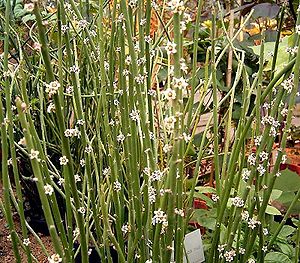Euphorbia antisyphilitica
| Euphorbia antisyphilitica | ||||||||||||
|---|---|---|---|---|---|---|---|---|---|---|---|---|

Euphorbia antisyphilitica |
||||||||||||
| Systematics | ||||||||||||
|
||||||||||||
| Scientific name | ||||||||||||
| Euphorbia antisyphilitica | ||||||||||||
| Zucc. |
Euphorbia antisyphilitica ( Syn .: Euphorbia cerifera Alcocer , Euphorbia occulta Klotzsch ) is a species of the genus Spurge ( Euphorbia ) in the family of the Spurge family(Euphorbiaceae). It isnative tosouthern North America and is used to obtain the raw plant material candelilla wax .
description
Euphorbia antisyphilitica forms branching bushes densely from the bases that reach heights of up to about 30 cm. A plant grown from seeds produces a subterranean, succulent to woody caudex up to about 5 cm in diameter. However, this is only rarely observed, as the plants mainly spread through rhizomes . The cylindrical, about 5 mm thick shoot axes are initially succulent , but lignify with age. They are leaf green and do not branch or (in culture) only slightly. A wax layer that is formed on the shoot axes and reduces evaporation is obtained industrially as candelilla wax . The linear, approximately 1 × 4 mm large leaves are quickly obsolete. The stipules are very small and glandular.
Short-stalked cyathia appear individually or in small groups from the leaf axils. Their reddish nectar glands have white appendages that look like bracts and thus give the cyathia almost the appearance of real flowers . The bald, almost spherical capsule fruits contain conical, slightly wrinkled seeds with tiny carunculae .
Distribution and systematics
Euphorbia antisyphilitica is native to semi-deserts of northern Mexico and the southwestern United States ( Texas , Arizona , California ). Because of its upright growth and flammable wax, it is called there, like other and similar types of milkweed, candelilla ("small candle").
The species was first described in 1832 by Joseph Gerhard Zuccarini .
Individual evidence
- ↑ Euphorbia antisyphilitica. In: Dep. Math.-phys. Cl. King. Bayer. Akad. Wiss. 1: 292, 1832. ( online )
Web links
- Profile (English)
- Entry in Plants for a Future (English)
